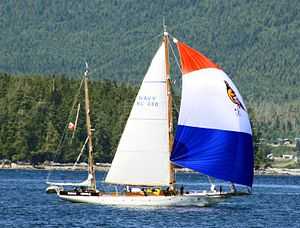HMCS Oriole
 HMCS Oriole in July 2011 | |
| Career (Canada) | |
|---|---|
| Name: | Oriole |
| Namesake: | Oriole, Oriolus aurum |
| Operator: | Royal Canadian Navy |
| Builder: | George Lawley & Son |
| Laid down: | Early 1921 |
| Launched: | 4 June 1921 |
| Commissioned: | 19 June 1952 |
| Homeport: | CFB Esquimalt. |
| Identification: | KC 480 |
| Honours and awards: | Dunkirk, 1940 |
| Badge: |
|
| General characteristics | |
| Class and type: | Sail training vessel |
| Type: | Ketch |
| Displacement: | 92 tonnes (70.760 kilograms) |
| Length: | 102 ft (31 m) |
| Beam: | 19 ft (5.8 m) |
| Height: | 105 ft (32 m) |
| Draught: | 10 ft (3.0 m) |
| Propulsion: | 15,700 sq ft (1,460 m2) of sail |
| Sail plan: | Marconi rig |
| Complement: | 1 senior officer, 2 senior petty officers (POs), 2 junior POs. 16 supernumary junior officers and POs. |
| Notes: | Auxiliary engine 261 hp (195 kW) Detroit Diesel |
HMCS Oriole is the sail training vessel of the Royal Canadian Navy based at CFB Esquimalt in Victoria, British Columbia. She is a 31-metre sailing ketch, currently the oldest commissioned vessel in the Royal Canadian Navy, and also the longest serving commissioned ship.
History
Oriole was originally laid down as Oriole IV, the successor in a line of vessels named Oriole that were in service as the flagships for the Royal Canadian Yacht Club of Toronto, Ontario. During the Second World War she was chartered by the Royal Canadian Navy as a training vessel. In 1949 she was again chartered by the Navy as a new recruit training vessel, and subsequently moved to Halifax, Nova Scotia, in 1951. She was officially commissioned HMCS Oriole 19 June 1952, and two years later the navy moved her to CFB Esquimalt to become a training vessel to the Naval Officer Training Centre.
Current status
Oriole provides sail training to junior officers and non-commissioned officers as part of their introduction to life at sea. She also provides a venue for teamwork exercises and adventure training available to all of the Canadian Forces. She participates in many events, races and public relation day sails in support of local charities.
Images
-

Ship's badge of HMCS Oriole
-
Ship's reference plaque
-

Arriving in Portland, Oregon, for the 2013 Rose Festival
See also
| Wikimedia Commons has media related to Oriole (ship, 1921). |
- List of Canadian Navy ships
